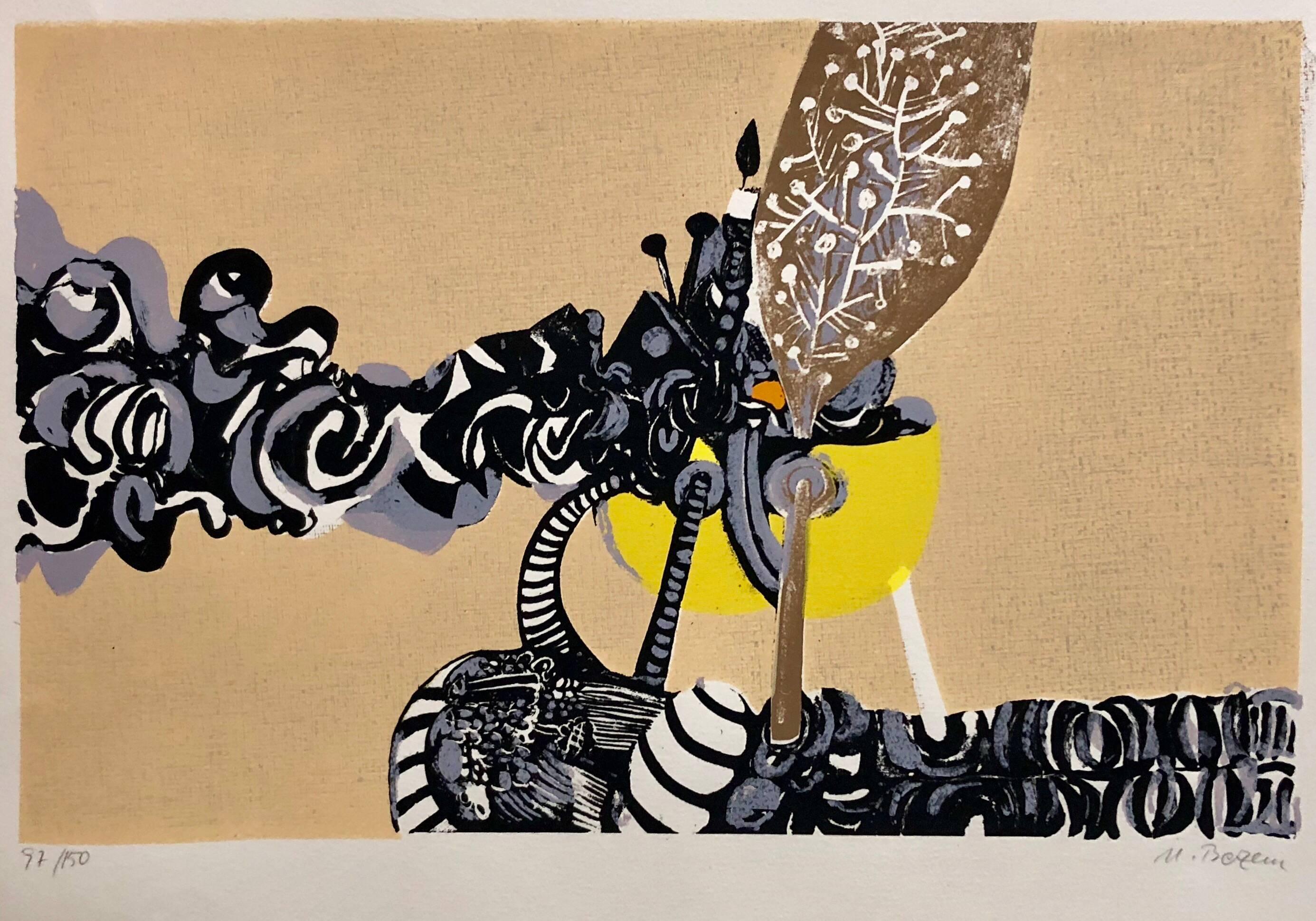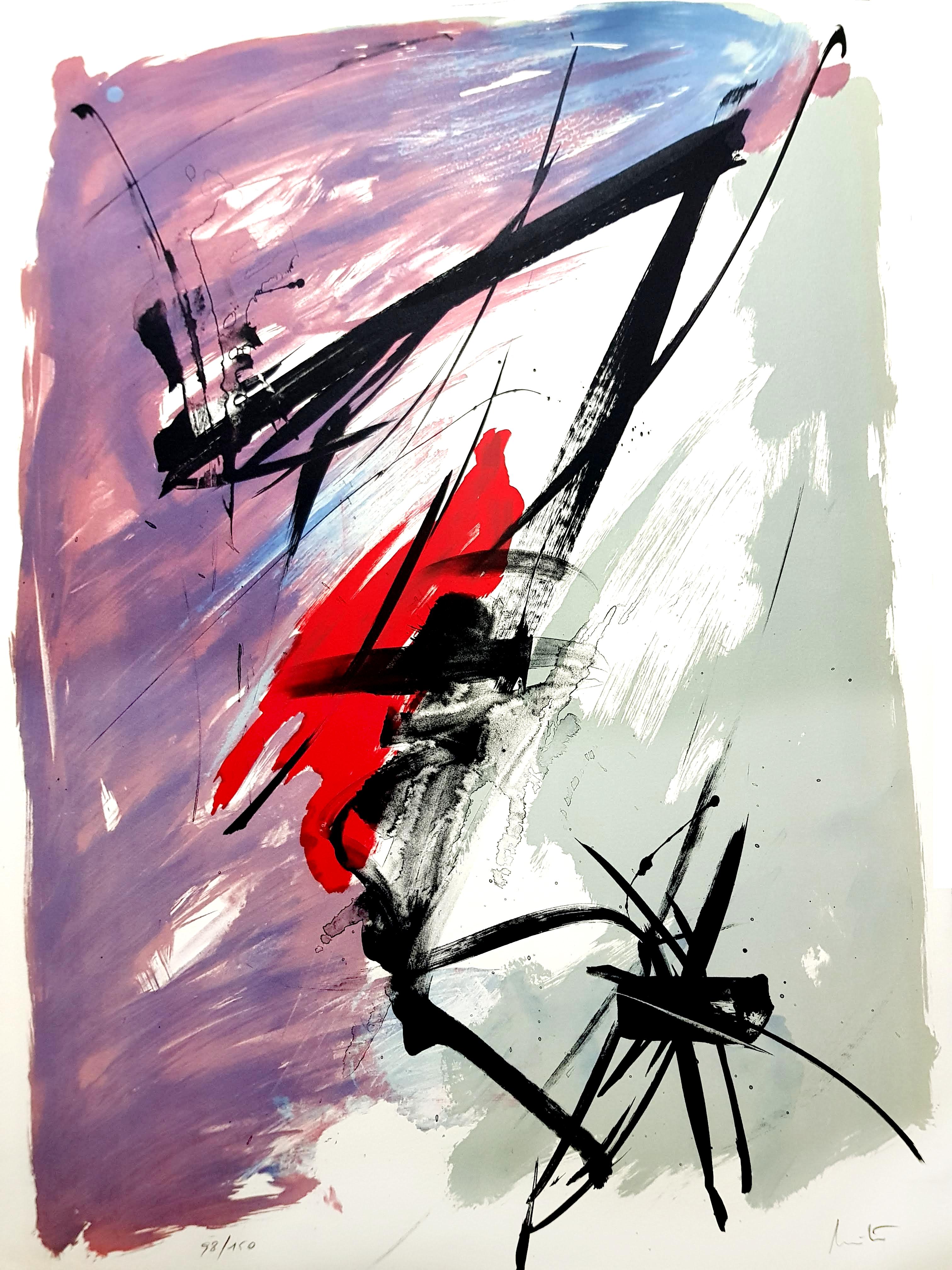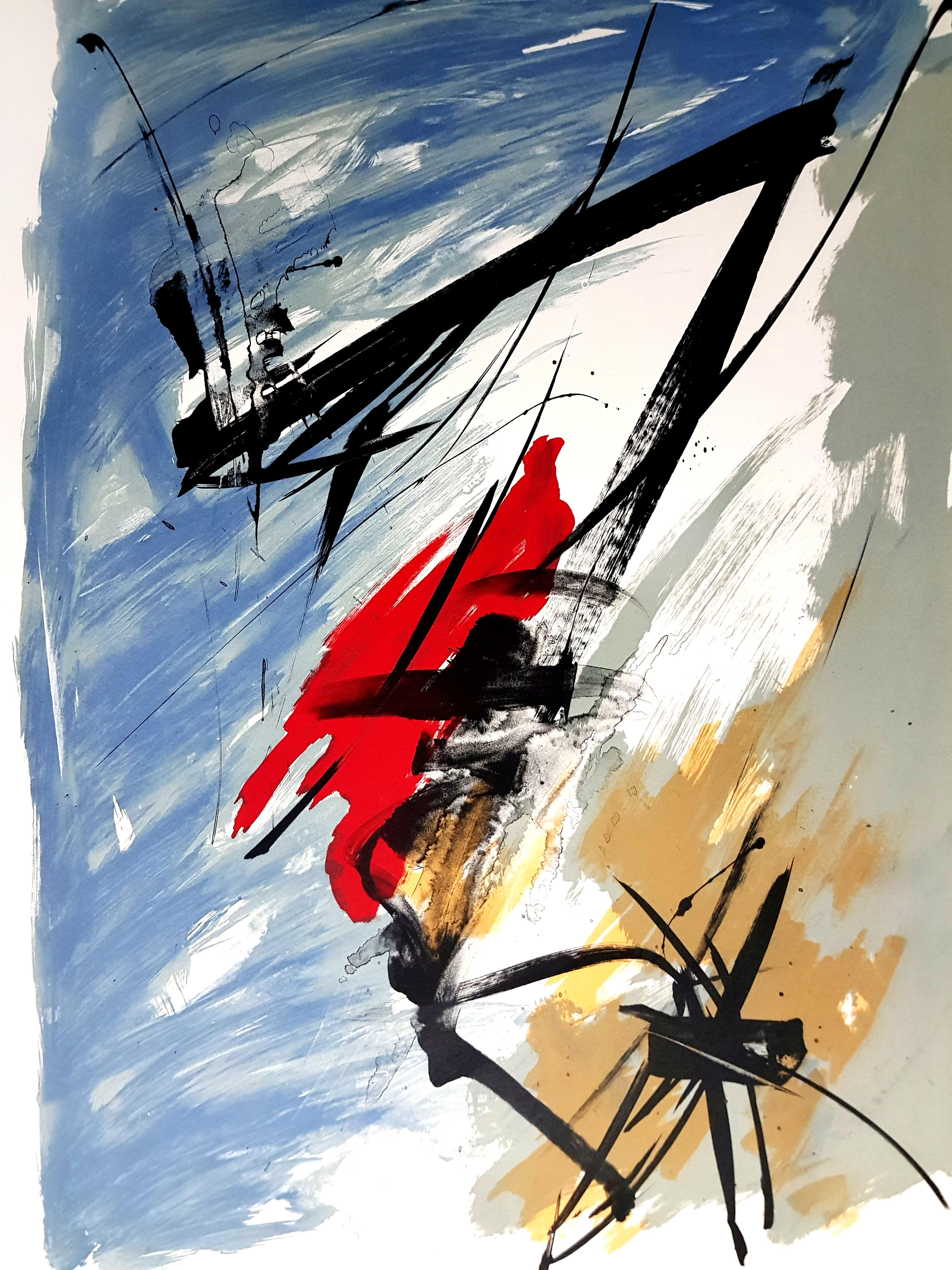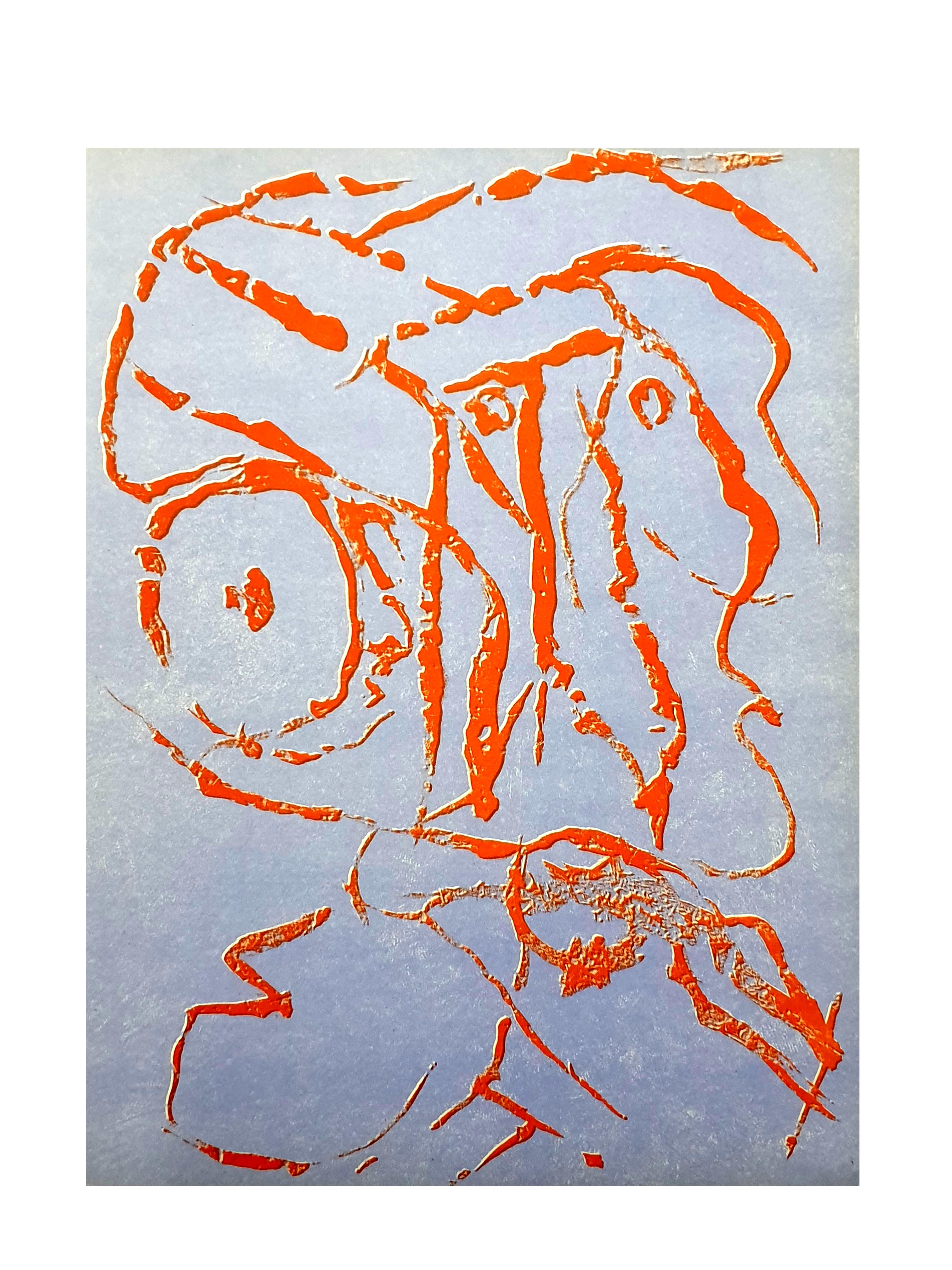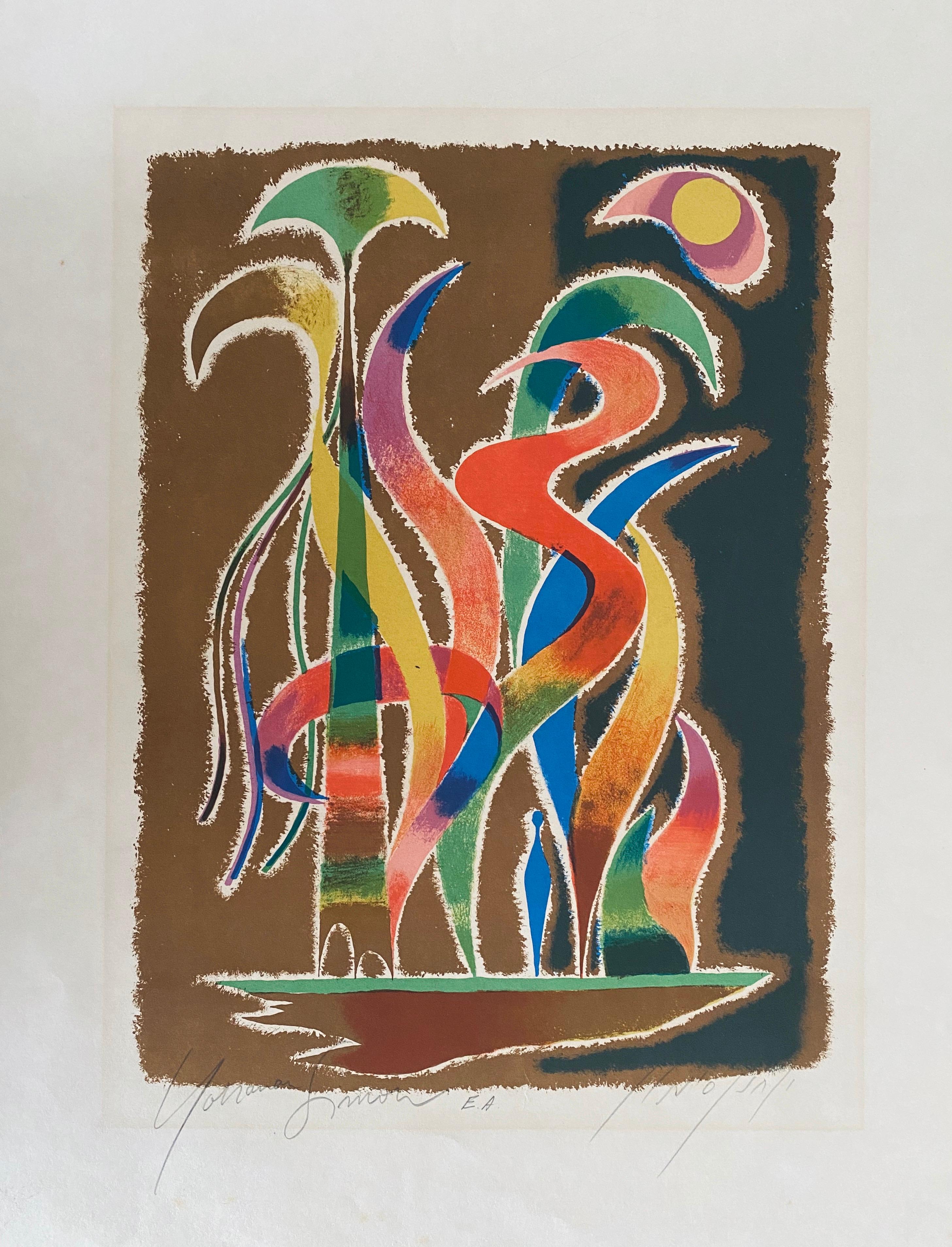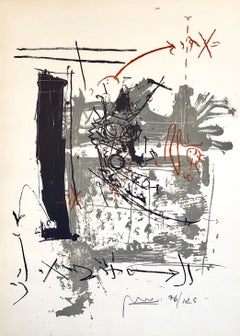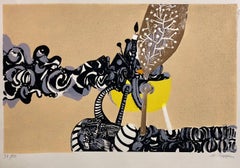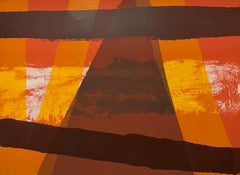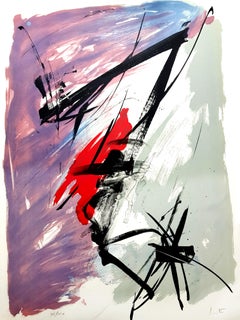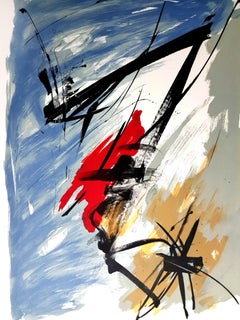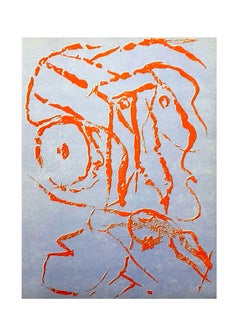Items Similar to Israeli Josef Zaritsky Abstract Modernist Lithograph Print "Composition"
Want more images or videos?
Request additional images or videos from the seller
1 of 9
Igael TumarkinIsraeli Josef Zaritsky Abstract Modernist Lithograph Print "Composition"c.1959
c.1959
$750
£581.53
€659.85
CA$1,075.09
A$1,169.01
CHF 615.95
MX$14,200.08
NOK 7,743.79
SEK 7,259.18
DKK 4,951.62
About the Item
Abstract Composition, 1959 Lithograph
This was from a portfolio which included works by Yosl Bergner, Menashe Kadishman, Yosef Zaritsky, Aharon Kahana, Moshe Tamir and Michael Gross.
Joseph (Yossef) Zaritsky (Hebrew: יוסף זריצקי; September 1, 1891 – November 30, 1985) was one of Israel's greatest artists and one of the early promoters of modern art in the Land of Israel both during the period of the Yishuv (Palestine, the body of Jewish residents in the Land of Israel before the establishment of the State of Israel) and after the establishment of the State. In 1948 Zaritsky was one of the founders of the "Ofakim Hadashim" group. In his works he created a uniquely Israeli style of abstract art, which he sought to promote by means of the group. For this work he was awarded the Israel Prize for painting in 1959.
Joseph Zaritsky was born in 1891 in Borispol, in the Poltava Oblast (province), in the Southwestern portion of the Russian Empire (today the Kiev Oblast of the Ukraine), to a large, traditional Jewish family. His parents, Golda and Joseph Ben Ya'acov, were farmers with National-Zionist leanings. One of the main expressions of this was their devoting of two rooms in their home to the study of Hebrew and reading. From 1910 to 1914 he studied art at the Academy of Arts in the city of Kiev. Among the artists that influenced Zaritsky was the Russian Symbolist painter Mikhail Vrubel. In 1915, during World War I, Zaritsky was conscripted into the Russian Army, where he served until 1917.
Because of the pogrom of 1919, the family escaped to Kalarash, Bessarabia, leaving behind all his works and art up to that point. In Kalarash he stayed in his father-in-law's home, where he painted small-scale watercolors, of which only five have survived: three portraits of his wife and two rural landscapes. These small works are done in small dark colored dots, and they reflect the influence of Russian modernism. Zaritsky divided the format into a sort of mosaic on small canvases that blur the illusion of perspective.
In 1924 Zaritsky mounted his first solo exhibition in the club "Menorah" in Jerusalem. Another exhibition was opened in the Technion in Haifa. Zaritsky and the sculptor Abraham Melnikov, were the initiators of the first of the exhibitions of Israeli artists in the Tower of David. Also, from 1927 he served as the Chairman of the Israel Painters and Sculptors Association.
In the middle of the 1920s Zaritsky moved to Tel Aviv and continued to paint the series of landscapes that he had started in Jerusalem. The landscapes and portraits of that he painted during these years show his effort to create an artistic language appropriate to description.
In 1927 Zaritsky left his family behind and went to Paris for a stay of several months.
In 1929 Zaritsky participated in the "Egged" group's exhibition, held in an apartment on Allenby Street in Tel Aviv, in which artists such as Sionah Tagger, Arieh Lubin, and Pinchas Litvinovsky, among others, also participated. The works of this group show the influence of late French post-modernism (primarily of the "School of Paris"), which was popular among the artists of the Land of Israel. The exhibition "The Bezalel National Museum" in 1930 placed him firmly in the public consciousness as a modernist artist. “Even the red curtain," Greenberg writes, "which in his paintings reminds us of the abstraction of Kandinsky, even this red is restrained, and its judgment as red becomes just a matter of a wintry sunset."
Between 1932 and 1933, Zaritsky opened an art "studia" adjoining the basement of the home where he lived on 18 Mapu Street. Among the artists who came to his studio were Yehiel Krize, Arie Aroch. Zaritsky’s watercolor paintings – a unique interpretation of Cézanne and of the Russian symbolist painting (Vrubel) – received recognition from the moment of his aliyah in 1923. Joseph Zaritsky's still lifes and portraits from the end of the 1920s and the 1930s, show the influence of French intimiste painting and sometimes of Matisse. From the middle of the 1930s to the middle of the 1940s Zaritsky concentrated on describing one urban landscape – the view of Tel Aviv roofs from the window of his studio or from the roof of his house. These works of Zaritsky’s are a milestone in the history of Israeli art both because of their high quality and because they represent an important stage in Zaritsky’s movement toward abstraction. They represent the influence of French art in the 1930s. They also relate to the modernist, contemporary aspect of the modern architecture of Tel Aviv, and to painting for its own sake and not to a figurative theme. The level of sophistication and the depth with which he dealt with the principles of painting are milestones in themselves. Artists such as Pinchas Abramovich, Yehiel Krize, Arie Aroch, and Shimshon Holzman were all pupils of Zaritsky during those years. And in addition to them, he had a great influence on many other artists. Zaritsky turned his gaze away from the view of the beach which occupied his contemporaries, like Nahum Gutman, Reuven Rubin, etc., to views of the new, modern city spread out to his north and east. In 1941 he mounted a solo exhibition in the Habima building in honor of his 50th birthday. In 1942 Zaritsky won the Dizengoff Prize for Painting.
The motive behind the founding of an alternative to the general art association came into being in 1948, with an invitation to mount an exhibition of Israeli artists at the Italian pavilion of the Venice Biennale. On November 9, 1948 the new group mounted an exhibition of 18 member artists in the Tel Aviv Museum of Art, under the name "New Horizons." While artists such as Yohanan Simon, Moshe Castel, and Marcel Janco dealt with Zionist and Jewish symbolism, Zaritsky chose for the exhibition an abstract still life influenced by the cubist painter Georges Braque.
In 1957 the government of Israel decided to put on a large national display in honor of the tenth anniversary of the founding of the State of Israel. Among the outstanding works were a large steel sculpture by Yechiel Shemi, "Sculpture of the Decade" by Itzhak Danziger , a frieze by Yaakov Wechsler, etc. Another notable work was Zaritsky's painting "Otsma" (Power), which had been commissioned by Avraham Yaski, a designer in the "Department of Economic Achievements."
In the 1980s Zaritsky would take up residence every summer in the studio he had received on Kibbutz Tzuba. At Tzuba he would paint watercolors, among them abstract nature paintings, from direct contemplation of nature. In the summer of 1983, Zaritsky painted a number of paintings in the studio in which he returned to the motif of the window, which he had used in the past. In addition, in the 1980s Zaritsky created a number of paintings, some of them monumental in size, constructed along the lines of painters like Goya, Pablo Picasso, Marc Chagall, etc.
In 1980 one of Zaritsky's watercolors from 1924 was sold at a public auction in the Gordon Gallery for $79,000. In 1979 he was interviewed on television for the first time on Gideon Ofrat's show "Taste and Smell." In 1981 the Israeli Postal Authority issued a stamp depicting Zaritsky’s “Jerusalem: The View from Jaffa Gate” (1927). In 1981 Marc Scheps, Director of the Tel Aviv Museum of Art, named Zaritsky recipient of the Yakir Ha'ir (Esteemed of the City) award; In January 1982 there was a festive screening of the film "Portrait of an Artist: Joseph Zaritsky” (1981; 32 min.), directed by Jachin Hirsch, under the auspices of the Ministry of Education and the Israel Film Service. In 1985 the Tel Aviv Museum Art hosted a retrospective exhibition of Zaritsky’s art that included 340 of his works.
- Creator:Igael Tumarkin (1933, German, Israeli)
- Creation Year:c.1959
- Dimensions:Height: 20 in (50.8 cm)Width: 27 in (68.58 cm)Depth: 2 in (5.08 cm)
- Medium:
- Movement & Style:
- Period:
- Condition:minor wear, please see photos.
- Gallery Location:Surfside, FL
- Reference Number:1stDibs: LU38214372972
About the Seller
4.9
Platinum Seller
Premium sellers with a 4.7+ rating and 24-hour response times
Established in 1995
1stDibs seller since 2014
1,824 sales on 1stDibs
Typical response time: 1 hour
- ShippingRetrieving quote...Shipping from: Surfside, FL
- Return Policy
Authenticity Guarantee
In the unlikely event there’s an issue with an item’s authenticity, contact us within 1 year for a full refund. DetailsMoney-Back Guarantee
If your item is not as described, is damaged in transit, or does not arrive, contact us within 7 days for a full refund. Details24-Hour Cancellation
You have a 24-hour grace period in which to reconsider your purchase, with no questions asked.Vetted Professional Sellers
Our world-class sellers must adhere to strict standards for service and quality, maintaining the integrity of our listings.Price-Match Guarantee
If you find that a seller listed the same item for a lower price elsewhere, we’ll match it.Trusted Global Delivery
Our best-in-class carrier network provides specialized shipping options worldwide, including custom delivery.More From This Seller
View AllIsraeli Tumarkin Abstract Modernist Graffiti Art Lithograph Print "Broken Hour"
Located in Surfside, FL
This was from a portfolio which included works by Yosl Bergner, Menashe Kadishman, Yosef Zaritsky, Aharon Kahana, Moshe Tamir and Michael Gross.
Yigal Tumarkin (also Igael Tumarkin...
Category
1950s Modern Abstract Prints
Materials
Lithograph
Rare Israeli Surrealist Judaica Abstract Lithograph Naftali Bezem
By Naftali Bezem
Located in Surfside, FL
Fine lithograph on deckle edged French Arches paper. Pencil signed and numbered from edition of 150.
A Surrealist Judaica scene of a bearded man (Rabbi) in a boat with Shabbat candlesticks. with blindstamp from Editions Empreinte in Paris, France. (They published, Jean Michel Folon, Sempe, Raoul Ubac, Raymond Savignac, Cesar, Bengt Lindstrom , Paul Aizpiri and many other modern masters.
Naftali Bezem (Hebrew: נפתלי בזם; born November 27, 1924) is an Israeli painter, muralist, and sculptor.
Bezem was born in Essen, Germany, in 1924. His early adolescence was spent under Nazi oppression, in constant fear for the safety of his parents, who perished in the Holocaust in the Polish Auschwitz concentration camp. Naftali emigrated to Mandate Palestine in 1939, at the age of fourteen with a Youth Aliyah group.
From 1943 to 1946, he studied art at the Bezalel Academy of Art and Design in Jerusalem with Israeli painter Mordecai Ardon. He then spent three years studying in Paris.His most famous public works include a wall relief at Yad Vashem in Jerusalem and the ceiling mural in the main reception room at the President's Residence, Jerusalem.In 1957, Bezem was a co-recipient of the Dizengoff Prize for Painting.
Group Exhibitions
Orit Art Gallery, Tel Aviv
Artists: Yosef Zaritsky, Marcel Janco, Lea Nikel, Robert Baser, Bezem, Michael Druks,
Israeli Painting (Watercolors and Gouache)
Artists:
Pinchas Abramovich, Bezem, Naftali Nachum Gutman, Haim Gliksberg, Mordechai Levanon, Avigdor Stematsky, Avshalom Okashi, Yehiel Krize...
Category
20th Century Modern Figurative Prints
Materials
Lithograph
German Israeli Artist Abstract Lithograph
By Yohanan Simon
Located in Surfside, FL
Yohanan Simon (Hebrew: יוחנן סימון; November 3, 1905 – January 16, 1976) was a German-born Israeli painter.
Yohanan Simon, painter was born in 1905, Berlin. From 1927 he lived main...
Category
Mid-20th Century Abstract Abstract Prints
Materials
Lithograph
Mod Abstract Expressionist Modernist Lithograph Edward Avedisian Color Field Art
By Edward Avedisian
Located in Surfside, FL
Edward Avedisian (1936-2007)
Cleo, Fur Queen, 1969
Lithograph in color on Arches wove paper.
Hand signed, dated and numbered in pencil.
Edition 100
Dimensions:
22.25 inches X 30.25...
Category
1960s Abstract Expressionist Abstract Prints
Materials
Lithograph
Pietro Consagra Italian Mod Abstract Expressionist Forma Brutalist Lithograph
By Pietro Consagra
Located in Surfside, FL
Pietro Consagra (Italian, 1920-2005).
Hand signed in pencil and numbered limited edition color lithograph on Magnani paper.
Embossed stamp with limited edition numbers in pencil to lower left, and having artist pencil signature to lower right.
(from a limited edition of 80 with 15 artist's proofs)
Published by Stamperia 2RC, Rome Italy and Marlborough Gallery, Rome, Italy.
Abstract Modernist work in colors, produced in the style of the Forma art movement of Postwar Italy, of which the artist was a prominent member.
Pietro Consagra (1920 – 2005) was an Italian Post war artist working in painting, printmaking and sculpture. In 1947 he was among the founding members of the Forma 1 group of artists, proponents of structured abstraction.
Consagra was born on 6 October 1920 in Mazara del Vallo, in the province of Trapani in south-western Sicily, to Luigi Consagra and Maria Lentini. From 1931 he enrolled in a trade school for sailors, studying first to become a mechanic, and later to become a captain. In 1938 he moved to Palermo, where he enrolled in the liceo artistico; despite an attack of tuberculosis, he graduated in 1941, and in the same year signed up at the Accademia di Belle Arti, where he studied sculpture under Archimede Campini. After the Invasion of Sicily and the Allied occupation of Palermo in 1943, Consagra found work as a caricaturist for the American Red Cross club of the city; he also joined the Italian Communist Party. Early in 1944, armed with a letter of introduction from an American officer, he travelled to Rome. There he came into contact with the Sicilian artist Concetto Maugeri, and through him with Renato Guttuso, who was also Sicilian and who introduced him to the intellectual life of the city and to other postwar artists such as Leoncillo Leonardi, Mario Mafai and Giulio Turcato. Consagra signed up at the Accademia di Belle Arti di Roma in September 1944 and studied sculpture there under Michele Guerrisi, but left before completing his diploma.
In 1947, with Carla Accardi, Ugo Attardi, Piero Dorazio, Mino Guerrini, Achille Perilli, Antonio Sanfilippo and Giulio Turcato, Consagra started the artist's group Forma 1, which advocated both Marxism and structured abstraction.
Steadily Consagra's work began to find an audience. Working primarily in metal, and later in marble and wood, his thin, roughly carved reliefs, began to be collected by Peggy Guggenheim and other important patrons of the arts. He showed at the Venice Biennale eleven times between 1950 and 1993, and in 1960 won the sculpture prize at the exhibition. During the 1960s he was associated with the Continuità group, an offshoot of Forma I, and in 1967 taught at the School of Arts in Minneapolis. Large commissions allowed him to begin working on a more monumental scale, and works of his were installed in the courtyard of the Foreign Ministry in Rome and in the European Parliament, Strasbourg. His work is found in the collections of The Tate Gallery, London, in Museo Cantonale d'Arte of Lugano and the Museum of Modern Art, Paris, and the National Gallery of Art in Washington, D.C..
Consagra returned to Sicily where he sculpted a number of significant works during the 1980s. With Senator Ludovico Corrao, he helped created an open-air museum in the new town of Gibellina, after the older town had been destroyed in the earthquake of 1968. Consagra designed the gates to the town's entrance, the building named "Meeting" and the gates to the cemetery, where he was later buried.
In 1952 Consagra published La necessità della scultura ("the need for sculpture"), a response to the essay La scultura lingua morta ("sculpture, a dead language"), published in 1945 by Arturo Martini. Other works include L'agguato c'è ("the snare exists", 1960), and La città frontale ("the frontal city", 1969). His autobiography, Vita Mia, was published by Feltrinelli in 1980. In 1989 a substantial retrospective exhibition of work by Consagra was shown at the Galleria Nazionale d'Arte Moderna in Rome; in 1993 a permanent exhibition of his work was installed there. In 1991 his work was shown in the Hermitage Museum in St. Petersburg. In 2002 the Galerie der Stadt Stuttgart opened a permanent exhibition of his work. He was one of ten artists invited by Giovanni Carandente, along with David Smith, Alexander Calder, Arnaldo Pomodoro, Lynn Chadwick, and Beverly Pepper, to fabricate works in Italsider factories in Italy for an outdoor exhibition, "Sculture nella città", held in Spoleto during the summer of 1962. He was included in the The 1962 International Prize for Sculpture the jury included Argan, Romero Brest and James Johnson Sweeney the former director of the Solomon R. Guggenheim Museum in New York. The participants included Louise Nevelson and John Chamberlain for the United States; Lygia Clark for Brazil; Pietro Consagra, Lucio Fontana, Nino Franchina, and Gió Pomodoro for Italy; Pablo Serrano for Spain; and Eduardo Paolozzi, William Turnbull, and Kenneth Armitage for England. Gyula Kosice, Noemí Gerstein, Julio Gero, Naum Knop...
Category
1960s Abstract Expressionist Abstract Prints
Materials
Lithograph
Israeli Surrealist Judaica Abstract Lithograph Naftali Bezem
By Naftali Bezem
Located in Surfside, FL
Naftali Bezem (Hebrew: נפתלי בזם; born November 27, 1924) is an Israeli painter, muralist, and sculptor.
Bezem was born in Essen, Germany, in 1924. His early adolescence was spent...
Category
20th Century Modern Prints and Multiples
Materials
Lithograph
You May Also Like
Jean Miotte - Abstract Composition - Original Signed Lithograph
By Jean Miotte
Located in Collonge Bellerive, Geneve, CH
Jean Miotte - Rare Original Signed Lithograph
Title: Abstract Composition
Dimensions: 76 x 56 cm
Edition: 98/150
Signed and Numbered in pencil
Jean Miotte, 1926 - 2016
Miotte came ...
Category
1970s Abstract Expressionist Abstract Prints
Materials
Aquatint
Jean Miotte - Abstract Composition - Original Aquatint Engraving
By Jean Miotte
Located in Collonge Bellerive, Geneve, CH
Jean Miotte - Rare Original Aquatint Engraving
Title: Abstract Composition
Dimensions: 76 x 56 cm
Jean Miotte, 1926 - 2016
Miotte came of artistic age in the decade after World War...
Category
1970s Abstract Expressionist Abstract Prints
Materials
Aquatint
Pierre Alechinsky - Composition - Original Lithograph
Located in Collonge Bellerive, Geneve, CH
Pierre Alechinsky - Composition - Original Lithograph
From the literary review "XXe Siècle"
1960
Dimensions: 32 x 24 cm
Publisher: G. di San Lazzaro.
Unsigned and unumbered as issued
Category
1960s Abstract Abstract Prints
Materials
Lithograph
Untitled II, Abstract Screenprint by Moshe Kupferman
By Moshe Kupferman
Located in Long Island City, NY
Artist: Moshe Kupferman, Israeli (1926 - 2003)
Title: Untitled II
Year: 1997
Medium: Screenprint, signed and numbered in pencil
Edition: 40
Image Size: 30 x 45 inches
Size: 32 x 47....
Category
1990s Abstract Abstract Prints
Materials
Screen
Abstract Composition - Lithograph by Antoni Clavé - 1970s
By Antoni Clavé
Located in Roma, IT
Abstract Composition is original lithograph realized by the artist Antoni Clavè.
Hand signed on the lower right margin.
Numbered on the lower left margin. This original print is from an edition of 50.
Good conditions.
Antoni Clavé (Barcelona, 1913 – St. Tropez, 2005)
Antoni Clavé was a Catalan master painter, printmaker, sculptor, stage designer and costume designer. Nominated for two Academy Awards as Best Art Direction and Best Costume Design for his work for a Andersen's movie in 1952.
One of Spain's best known and most celebrated artists, he changed his style, evolving from baroque, ornamental style to a minimal aesthetic. He is best known for his lyrical abstractions, artworks combing paint...
Category
1970s Abstract Abstract Prints
Materials
Lithograph
Alberto Magnelli - Composition - Original Lithograph
By Alberto Magnelli
Located in Collonge Bellerive, Geneve, CH
Alberto Magnelli
Composition
Lithograph
Conditions: excellent
32 x 24 cm
1951
Executed for XXe siècle
Published by San Lazzaro, Paris
Unsigned and unnumbered as issued
Category
1950s Abstract Geometric Abstract Prints
Materials
Lithograph

